Macroeconomics: Analyzing Economic Equilibrium, GDP, and Expenditure
VerifiedAdded on 2021/01/02
|8
|1279
|293
Homework Assignment
AI Summary
This economics assignment addresses key macroeconomic concepts, beginning with an explanation of economic equilibrium and its determinants, referencing the expenditure-output model and Keynesian economics. It then analyzes the impact of various economic events, such as changes in the official cash rate, infrastructure spending, recession in China, and business confidence, on a country's GDP and price levels. The assignment includes a table illustrating the relationship between national income, aggregate consumption, and aggregate expenditure, demonstrating the stability of these factors. Finally, it discusses the Gross Domestic Product (GDP) as an indicator of a society's standard of living, acknowledging its limitations while highlighting its importance in measuring economic well-being. The assignment is well-supported by references to academic sources and includes an appendix with calculations.

Question
Answer
Answer
Paraphrase This Document
Need a fresh take? Get an instant paraphrase of this document with our AI Paraphraser
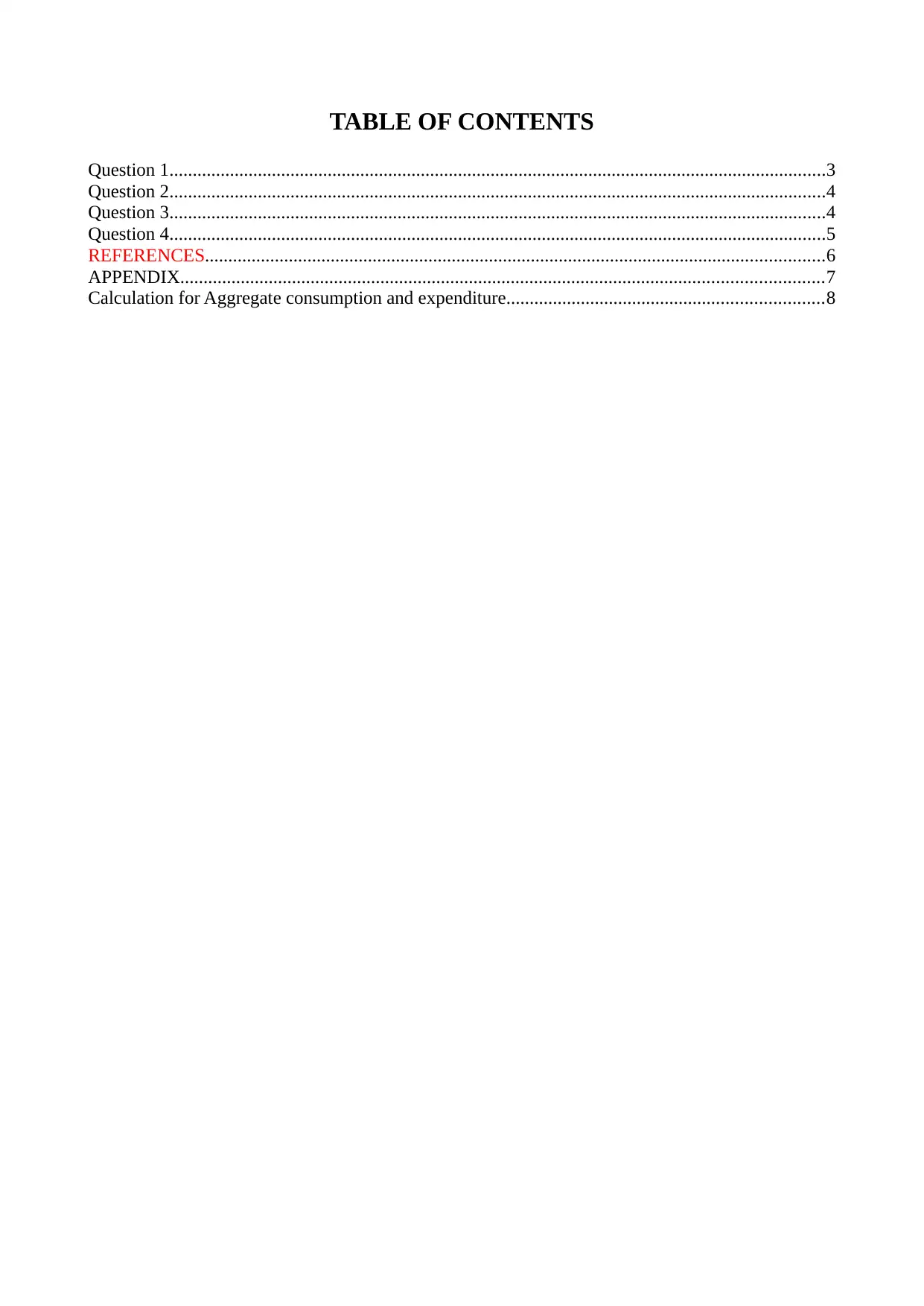
TABLE OF CONTENTS
Question 1.............................................................................................................................................3
Question 2.............................................................................................................................................4
Question 3.............................................................................................................................................4
Question 4.............................................................................................................................................5
REFERENCES.....................................................................................................................................6
APPENDIX..........................................................................................................................................7
Calculation for Aggregate consumption and expenditure....................................................................8
Question 1.............................................................................................................................................3
Question 2.............................................................................................................................................4
Question 3.............................................................................................................................................4
Question 4.............................................................................................................................................5
REFERENCES.....................................................................................................................................6
APPENDIX..........................................................................................................................................7
Calculation for Aggregate consumption and expenditure....................................................................8
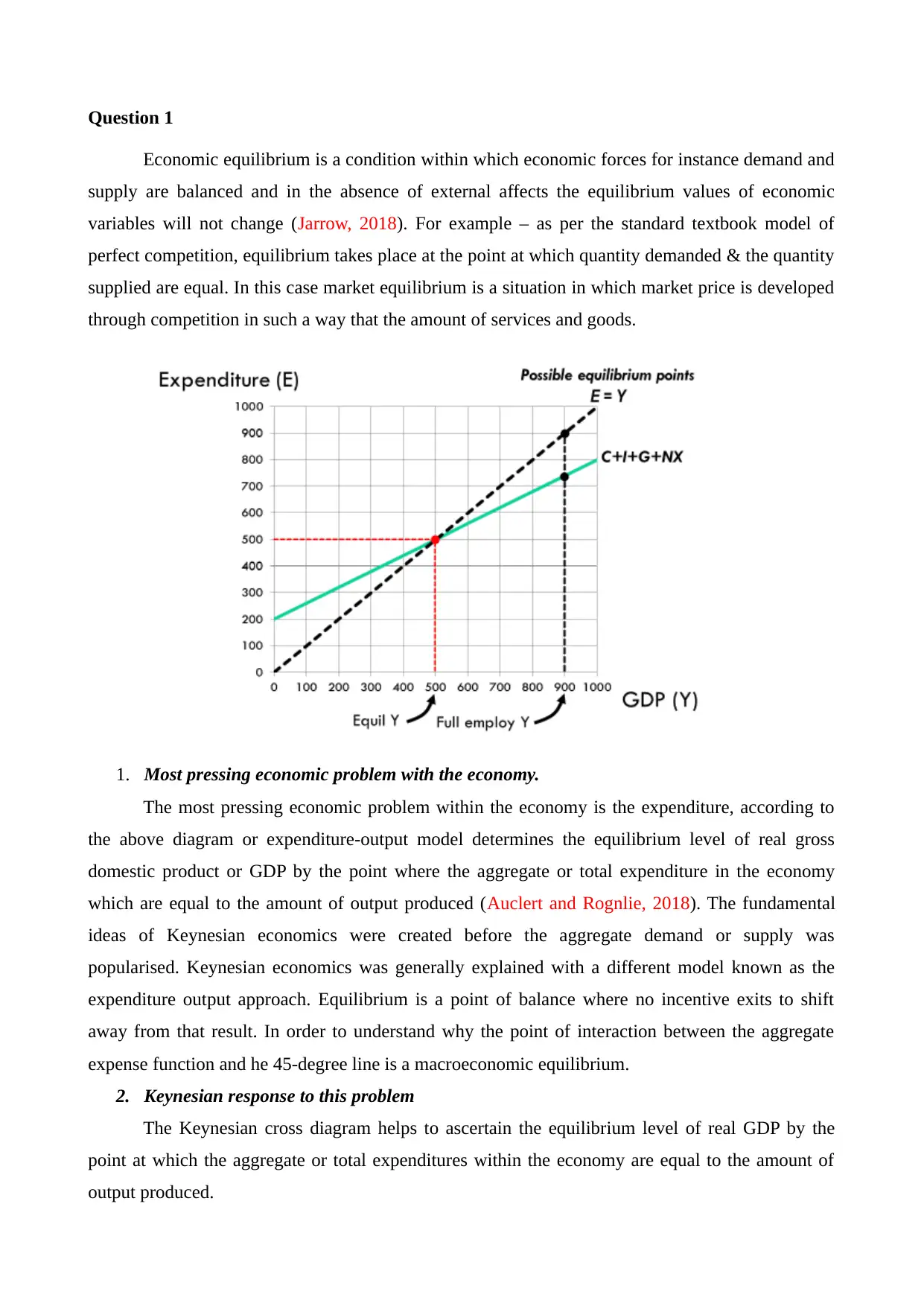
Question 1
Economic equilibrium is a condition within which economic forces for instance demand and
supply are balanced and in the absence of external affects the equilibrium values of economic
variables will not change (Jarrow, 2018). For example – as per the standard textbook model of
perfect competition, equilibrium takes place at the point at which quantity demanded & the quantity
supplied are equal. In this case market equilibrium is a situation in which market price is developed
through competition in such a way that the amount of services and goods.
1. Most pressing economic problem with the economy.
The most pressing economic problem within the economy is the expenditure, according to
the above diagram or expenditure-output model determines the equilibrium level of real gross
domestic product or GDP by the point where the aggregate or total expenditure in the economy
which are equal to the amount of output produced (Auclert and Rognlie, 2018). The fundamental
ideas of Keynesian economics were created before the aggregate demand or supply was
popularised. Keynesian economics was generally explained with a different model known as the
expenditure output approach. Equilibrium is a point of balance where no incentive exits to shift
away from that result. In order to understand why the point of interaction between the aggregate
expense function and he 45-degree line is a macroeconomic equilibrium.
2. Keynesian response to this problem
The Keynesian cross diagram helps to ascertain the equilibrium level of real GDP by the
point at which the aggregate or total expenditures within the economy are equal to the amount of
output produced.
Economic equilibrium is a condition within which economic forces for instance demand and
supply are balanced and in the absence of external affects the equilibrium values of economic
variables will not change (Jarrow, 2018). For example – as per the standard textbook model of
perfect competition, equilibrium takes place at the point at which quantity demanded & the quantity
supplied are equal. In this case market equilibrium is a situation in which market price is developed
through competition in such a way that the amount of services and goods.
1. Most pressing economic problem with the economy.
The most pressing economic problem within the economy is the expenditure, according to
the above diagram or expenditure-output model determines the equilibrium level of real gross
domestic product or GDP by the point where the aggregate or total expenditure in the economy
which are equal to the amount of output produced (Auclert and Rognlie, 2018). The fundamental
ideas of Keynesian economics were created before the aggregate demand or supply was
popularised. Keynesian economics was generally explained with a different model known as the
expenditure output approach. Equilibrium is a point of balance where no incentive exits to shift
away from that result. In order to understand why the point of interaction between the aggregate
expense function and he 45-degree line is a macroeconomic equilibrium.
2. Keynesian response to this problem
The Keynesian cross diagram helps to ascertain the equilibrium level of real GDP by the
point at which the aggregate or total expenditures within the economy are equal to the amount of
output produced.
⊘ This is a preview!⊘
Do you want full access?
Subscribe today to unlock all pages.

Trusted by 1+ million students worldwide
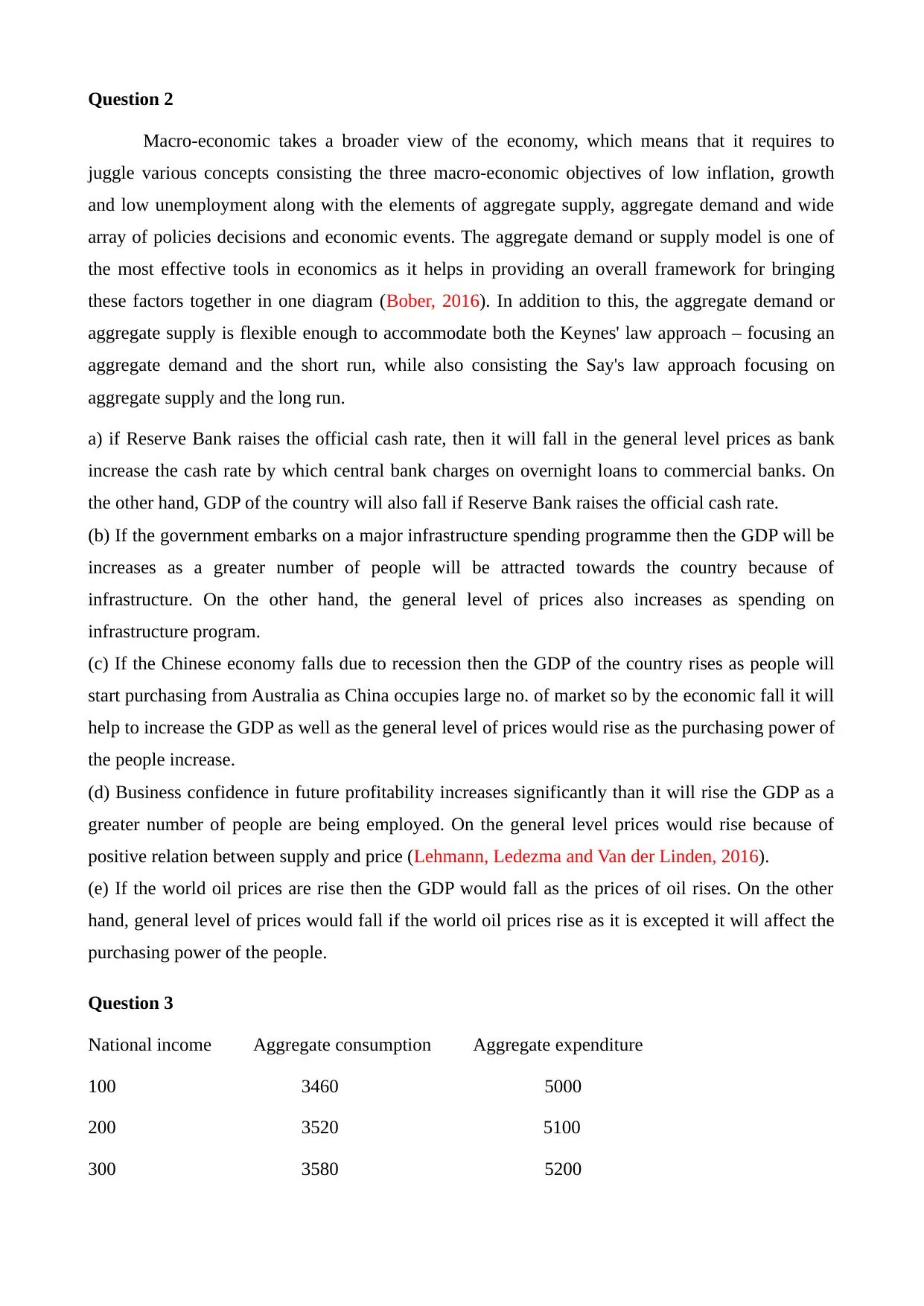
Question 2
Macro-economic takes a broader view of the economy, which means that it requires to
juggle various concepts consisting the three macro-economic objectives of low inflation, growth
and low unemployment along with the elements of aggregate supply, aggregate demand and wide
array of policies decisions and economic events. The aggregate demand or supply model is one of
the most effective tools in economics as it helps in providing an overall framework for bringing
these factors together in one diagram (Bober, 2016). In addition to this, the aggregate demand or
aggregate supply is flexible enough to accommodate both the Keynes' law approach – focusing an
aggregate demand and the short run, while also consisting the Say's law approach focusing on
aggregate supply and the long run.
a) if Reserve Bank raises the official cash rate, then it will fall in the general level prices as bank
increase the cash rate by which central bank charges on overnight loans to commercial banks. On
the other hand, GDP of the country will also fall if Reserve Bank raises the official cash rate.
(b) If the government embarks on a major infrastructure spending programme then the GDP will be
increases as a greater number of people will be attracted towards the country because of
infrastructure. On the other hand, the general level of prices also increases as spending on
infrastructure program.
(c) If the Chinese economy falls due to recession then the GDP of the country rises as people will
start purchasing from Australia as China occupies large no. of market so by the economic fall it will
help to increase the GDP as well as the general level of prices would rise as the purchasing power of
the people increase.
(d) Business confidence in future profitability increases significantly than it will rise the GDP as a
greater number of people are being employed. On the general level prices would rise because of
positive relation between supply and price (Lehmann, Ledezma and Van der Linden, 2016).
(e) If the world oil prices are rise then the GDP would fall as the prices of oil rises. On the other
hand, general level of prices would fall if the world oil prices rise as it is excepted it will affect the
purchasing power of the people.
Question 3
National income Aggregate consumption Aggregate expenditure
100 3460 5000
200 3520 5100
300 3580 5200
Macro-economic takes a broader view of the economy, which means that it requires to
juggle various concepts consisting the three macro-economic objectives of low inflation, growth
and low unemployment along with the elements of aggregate supply, aggregate demand and wide
array of policies decisions and economic events. The aggregate demand or supply model is one of
the most effective tools in economics as it helps in providing an overall framework for bringing
these factors together in one diagram (Bober, 2016). In addition to this, the aggregate demand or
aggregate supply is flexible enough to accommodate both the Keynes' law approach – focusing an
aggregate demand and the short run, while also consisting the Say's law approach focusing on
aggregate supply and the long run.
a) if Reserve Bank raises the official cash rate, then it will fall in the general level prices as bank
increase the cash rate by which central bank charges on overnight loans to commercial banks. On
the other hand, GDP of the country will also fall if Reserve Bank raises the official cash rate.
(b) If the government embarks on a major infrastructure spending programme then the GDP will be
increases as a greater number of people will be attracted towards the country because of
infrastructure. On the other hand, the general level of prices also increases as spending on
infrastructure program.
(c) If the Chinese economy falls due to recession then the GDP of the country rises as people will
start purchasing from Australia as China occupies large no. of market so by the economic fall it will
help to increase the GDP as well as the general level of prices would rise as the purchasing power of
the people increase.
(d) Business confidence in future profitability increases significantly than it will rise the GDP as a
greater number of people are being employed. On the general level prices would rise because of
positive relation between supply and price (Lehmann, Ledezma and Van der Linden, 2016).
(e) If the world oil prices are rise then the GDP would fall as the prices of oil rises. On the other
hand, general level of prices would fall if the world oil prices rise as it is excepted it will affect the
purchasing power of the people.
Question 3
National income Aggregate consumption Aggregate expenditure
100 3460 5000
200 3520 5100
300 3580 5200
Paraphrase This Document
Need a fresh take? Get an instant paraphrase of this document with our AI Paraphraser
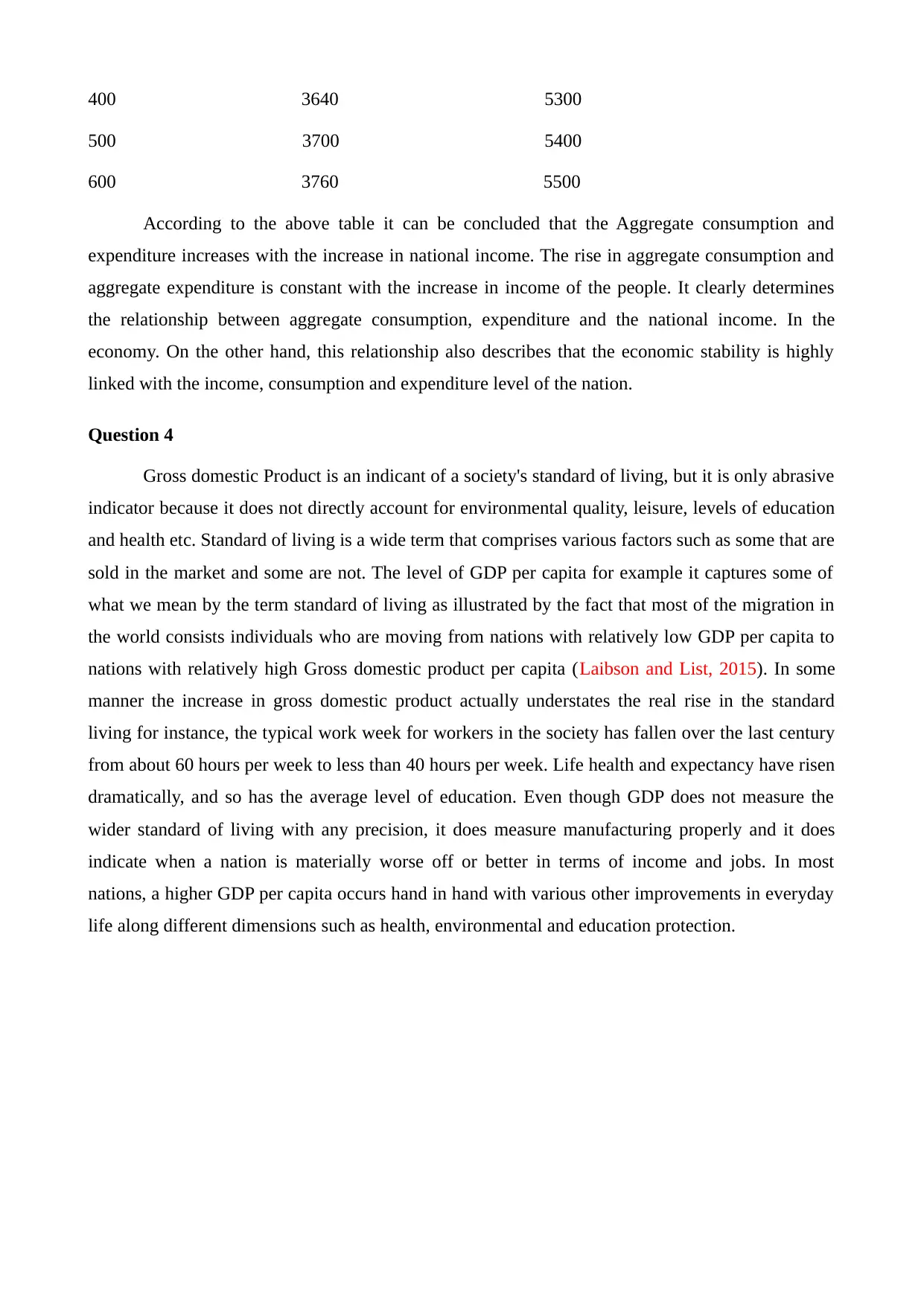
400 3640 5300
500 3700 5400
600 3760 5500
According to the above table it can be concluded that the Aggregate consumption and
expenditure increases with the increase in national income. The rise in aggregate consumption and
aggregate expenditure is constant with the increase in income of the people. It clearly determines
the relationship between aggregate consumption, expenditure and the national income. In the
economy. On the other hand, this relationship also describes that the economic stability is highly
linked with the income, consumption and expenditure level of the nation.
Question 4
Gross domestic Product is an indicant of a society's standard of living, but it is only abrasive
indicator because it does not directly account for environmental quality, leisure, levels of education
and health etc. Standard of living is a wide term that comprises various factors such as some that are
sold in the market and some are not. The level of GDP per capita for example it captures some of
what we mean by the term standard of living as illustrated by the fact that most of the migration in
the world consists individuals who are moving from nations with relatively low GDP per capita to
nations with relatively high Gross domestic product per capita (Laibson and List, 2015). In some
manner the increase in gross domestic product actually understates the real rise in the standard
living for instance, the typical work week for workers in the society has fallen over the last century
from about 60 hours per week to less than 40 hours per week. Life health and expectancy have risen
dramatically, and so has the average level of education. Even though GDP does not measure the
wider standard of living with any precision, it does measure manufacturing properly and it does
indicate when a nation is materially worse off or better in terms of income and jobs. In most
nations, a higher GDP per capita occurs hand in hand with various other improvements in everyday
life along different dimensions such as health, environmental and education protection.
500 3700 5400
600 3760 5500
According to the above table it can be concluded that the Aggregate consumption and
expenditure increases with the increase in national income. The rise in aggregate consumption and
aggregate expenditure is constant with the increase in income of the people. It clearly determines
the relationship between aggregate consumption, expenditure and the national income. In the
economy. On the other hand, this relationship also describes that the economic stability is highly
linked with the income, consumption and expenditure level of the nation.
Question 4
Gross domestic Product is an indicant of a society's standard of living, but it is only abrasive
indicator because it does not directly account for environmental quality, leisure, levels of education
and health etc. Standard of living is a wide term that comprises various factors such as some that are
sold in the market and some are not. The level of GDP per capita for example it captures some of
what we mean by the term standard of living as illustrated by the fact that most of the migration in
the world consists individuals who are moving from nations with relatively low GDP per capita to
nations with relatively high Gross domestic product per capita (Laibson and List, 2015). In some
manner the increase in gross domestic product actually understates the real rise in the standard
living for instance, the typical work week for workers in the society has fallen over the last century
from about 60 hours per week to less than 40 hours per week. Life health and expectancy have risen
dramatically, and so has the average level of education. Even though GDP does not measure the
wider standard of living with any precision, it does measure manufacturing properly and it does
indicate when a nation is materially worse off or better in terms of income and jobs. In most
nations, a higher GDP per capita occurs hand in hand with various other improvements in everyday
life along different dimensions such as health, environmental and education protection.
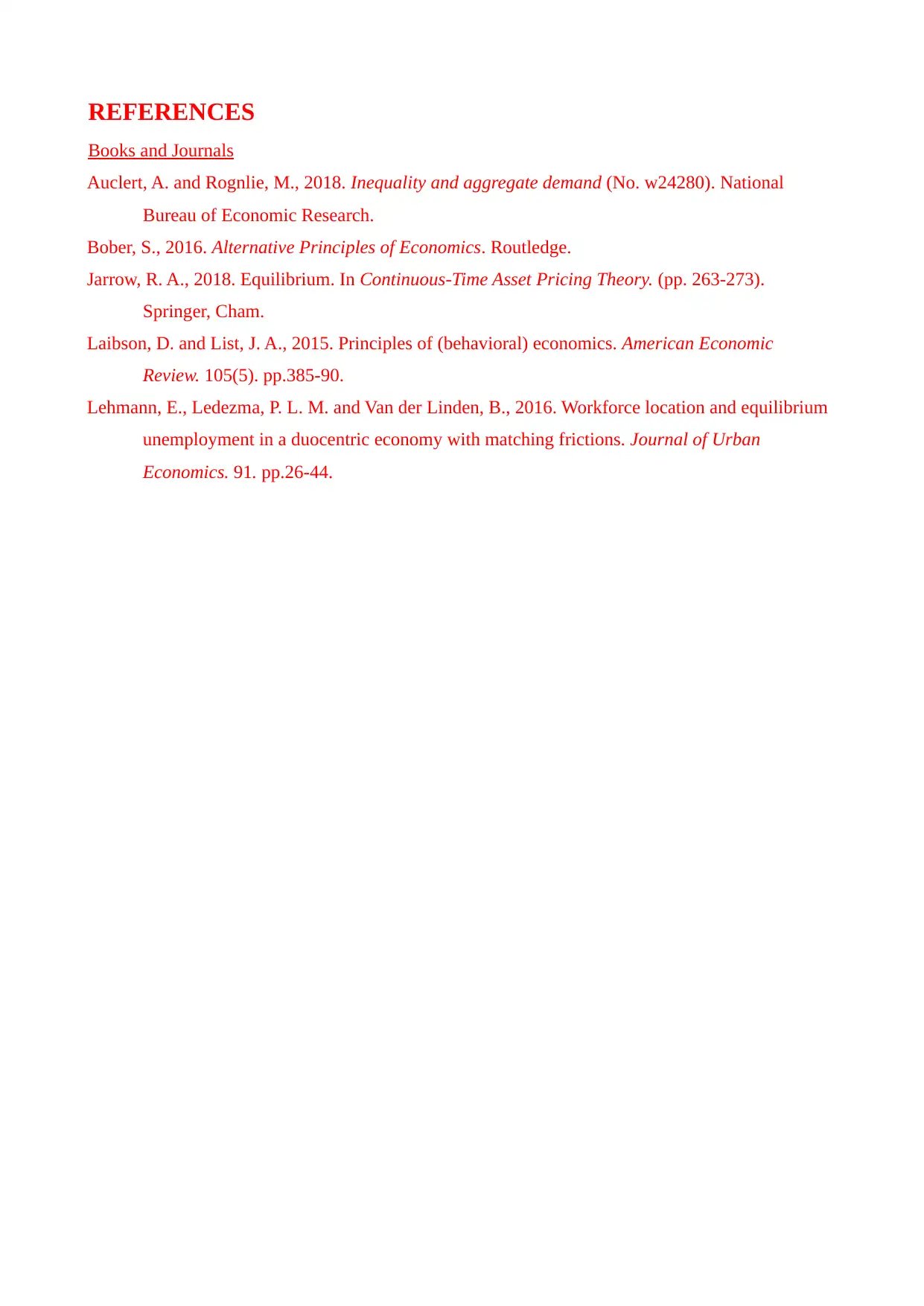
REFERENCES
Books and Journals
Auclert, A. and Rognlie, M., 2018. Inequality and aggregate demand (No. w24280). National
Bureau of Economic Research.
Bober, S., 2016. Alternative Principles of Economics. Routledge.
Jarrow, R. A., 2018. Equilibrium. In Continuous-Time Asset Pricing Theory. (pp. 263-273).
Springer, Cham.
Laibson, D. and List, J. A., 2015. Principles of (behavioral) economics. American Economic
Review. 105(5). pp.385-90.
Lehmann, E., Ledezma, P. L. M. and Van der Linden, B., 2016. Workforce location and equilibrium
unemployment in a duocentric economy with matching frictions. Journal of Urban
Economics. 91. pp.26-44.
Books and Journals
Auclert, A. and Rognlie, M., 2018. Inequality and aggregate demand (No. w24280). National
Bureau of Economic Research.
Bober, S., 2016. Alternative Principles of Economics. Routledge.
Jarrow, R. A., 2018. Equilibrium. In Continuous-Time Asset Pricing Theory. (pp. 263-273).
Springer, Cham.
Laibson, D. and List, J. A., 2015. Principles of (behavioral) economics. American Economic
Review. 105(5). pp.385-90.
Lehmann, E., Ledezma, P. L. M. and Van der Linden, B., 2016. Workforce location and equilibrium
unemployment in a duocentric economy with matching frictions. Journal of Urban
Economics. 91. pp.26-44.
⊘ This is a preview!⊘
Do you want full access?
Subscribe today to unlock all pages.

Trusted by 1+ million students worldwide

APPENDIX
Paraphrase This Document
Need a fresh take? Get an instant paraphrase of this document with our AI Paraphraser
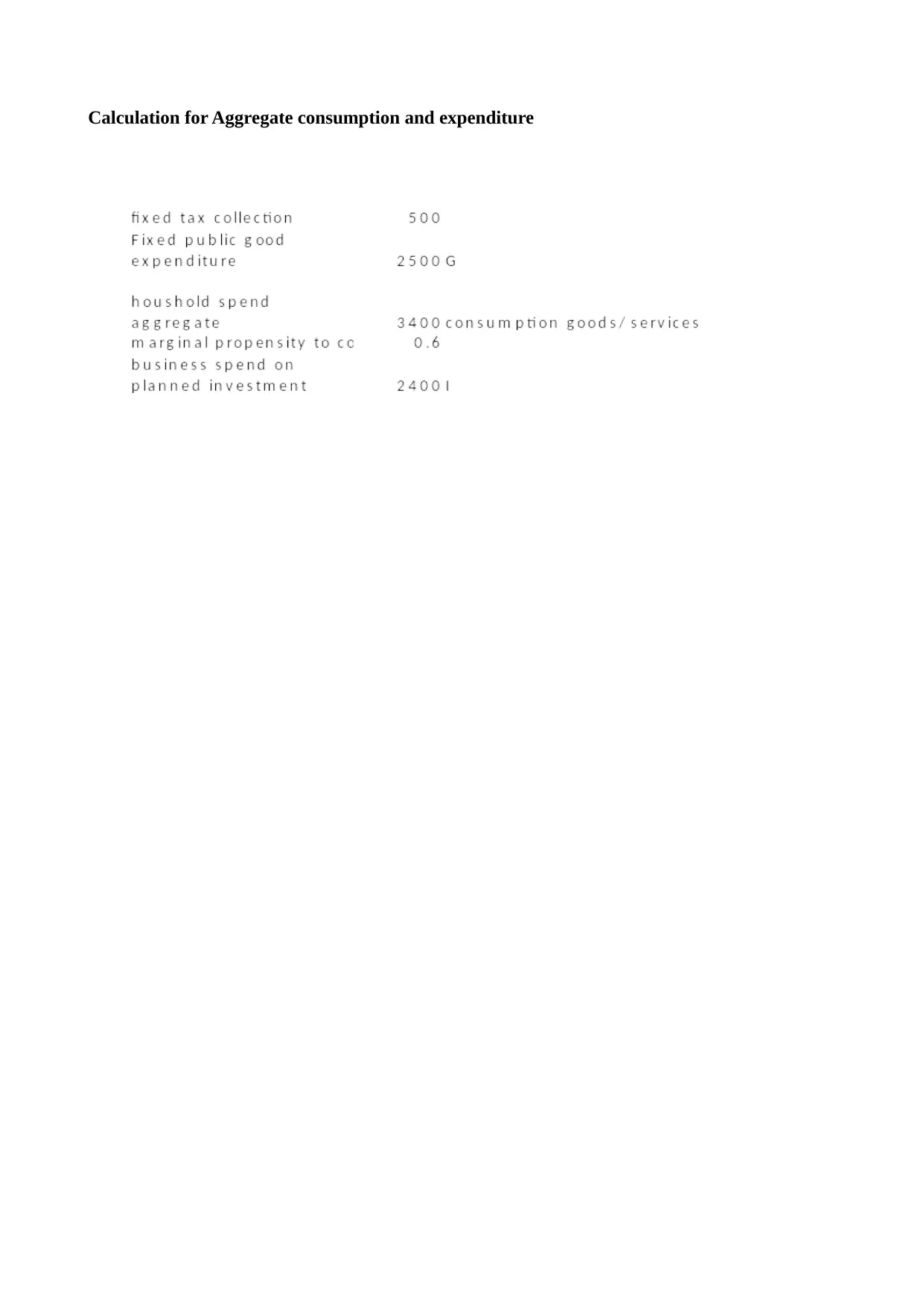
Calculation for Aggregate consumption and expenditure
1 out of 8
Related Documents
Your All-in-One AI-Powered Toolkit for Academic Success.
+13062052269
info@desklib.com
Available 24*7 on WhatsApp / Email
![[object Object]](/_next/static/media/star-bottom.7253800d.svg)
Unlock your academic potential
Copyright © 2020–2025 A2Z Services. All Rights Reserved. Developed and managed by ZUCOL.





